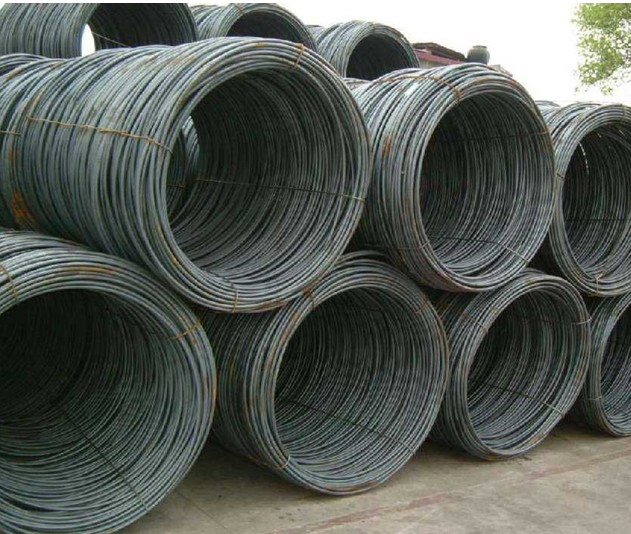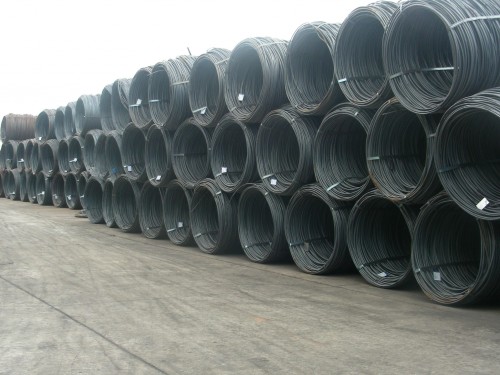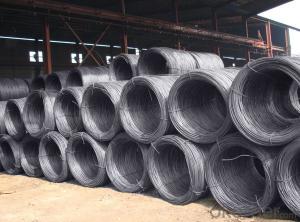hot rolled carbon steel wire rod Cold Heading Steel
- Loading Port:
- Tianjin
- Payment Terms:
- TT OR LC
- Min Order Qty:
- 30 m.t.
- Supply Capability:
- 45000 m.t./month
OKorder Service Pledge
Quality Product, Order Online Tracking, Timely Delivery
OKorder Financial Service
Credit Rating, Credit Services, Credit Purchasing
You Might Also Like
Packaging & Delivery
| Packaging Detail: | Packing: in coils, about 2 tons/coil or weight show each coil. shipment: in containers or by bulk |
| Delivery Detail: | 30 days |
Specifications
wire rod
1)Grade: Q195/235,SAE1006-1018B, H08A, 30MnSi , 62B-82B
2)Dia:5.5m-14mm
3)Price:$550-700 per ton
wire rod 1)Standard: Q195/235,SAE1006B/SAE1008B/SAE1010B/SAE1018B H08A, 30MnSi, 62B-82B 2)Dia:5.5mm-14mm 3)Packing: in coils 4)shipment: in containers or by bulk



- Q:How does the ductility of steel wire rod vary with different wire drawing processes?
- The ductility of steel wire rod can vary with different wire drawing processes. Generally, the wire drawing process involves pulling the wire rod through a series of dies to reduce its diameter. This process can increase the length of the wire rod while reducing its cross-sectional area. The ductility of the steel wire rod can be affected by several factors during the wire drawing process, such as the number of drawing passes, the speed of the drawing process, and the temperature at which it is performed. In certain cases, an increased number of drawing passes can lead to enhanced ductility as it allows for a more uniform reduction in diameter and a better alignment of the crystal structure. However, excessive drawing passes can also lead to work hardening and reduce the overall ductility of the wire rod. The speed of the wire drawing process can also impact ductility. Higher drawing speeds can result in increased strain rates, which can affect the mechanical properties of the wire rod. Slower drawing speeds, on the other hand, can allow for more controlled deformation and improved ductility. Additionally, the temperature at which the wire drawing is performed can influence ductility. Higher temperatures can enhance the ductility of the steel wire rod by reducing the strain hardening effect. However, excessive temperatures can also lead to undesirable grain growth and decrease the strength of the wire rod. Overall, the ductility of steel wire rod can vary with different wire drawing processes, and it is essential to optimize the drawing parameters to achieve the desired mechanical properties.
- Q:What are the different types of steel wire rod coatings used for high-temperature resistance?
- There are several types of steel wire rod coatings that are used for high-temperature resistance. These coatings are designed to protect the steel wire rod from oxidation, corrosion, and other forms of damage that can occur at elevated temperatures. One common type of coating used for high-temperature resistance is zinc. Zinc coatings provide excellent corrosion protection at high temperatures and are often used in applications where the steel wire rod will be exposed to extreme heat. Another type of coating that is commonly used for high-temperature resistance is aluminum. Aluminum coatings can withstand high temperatures and provide a barrier against oxidation and corrosion. Additionally, there are specialized coatings that are specifically designed for high-temperature resistance. These coatings often contain materials such as ceramic, refractory metals, or silicone-based compounds. Ceramic coatings, for example, are known for their ability to withstand extremely high temperatures and provide excellent thermal insulation. Refractory metal coatings, such as tungsten or molybdenum, are used in applications where the steel wire rod will be exposed to extremely high temperatures and harsh environments. Silicone-based coatings are known for their heat resistance and can provide a protective barrier against oxidation and corrosion. The choice of coating depends on the specific application and the desired level of high-temperature resistance. It is important to consider factors such as the operating temperature, the environment, and the level of protection required when selecting a coating for steel wire rod used in high-temperature applications.
- Q:How does the recycling process affect the mechanical properties of steel wire rod?
- The recycling process of steel wire rod can have both positive and negative effects on its mechanical properties. One of the main advantages of recycling steel wire rod is that it helps conserve natural resources and reduce the overall carbon footprint of the steel industry. By using scrap steel as a raw material, the recycling process can save energy and reduce emissions associated with mining and processing iron ore. This conservation of resources and reduction in energy consumption can indirectly contribute to the mechanical properties of the recycled steel wire rod. However, the recycling process can also introduce impurities and alloying elements that may affect the mechanical properties of the steel wire rod. During the melting and refining stages of the recycling process, impurities such as sulfur, phosphorous, and non-metallic inclusions can be introduced into the steel composition. These impurities can have adverse effects on the mechanical properties, such as reducing ductility, toughness, and fatigue strength. In addition, the recycling process may also lead to changes in the microstructure of the steel wire rod. The repeated heating and cooling cycles during melting, casting, and rolling can alter the grain size, grain boundaries, and phase distribution within the steel. These changes can impact the mechanical properties of the steel wire rod, such as its hardness, tensile strength, and elongation. To mitigate the potential negative effects of the recycling process on the mechanical properties of steel wire rod, various techniques and processes can be implemented. For instance, advanced refining methods can be employed to reduce impurities and control the chemical composition of the recycled steel. Additionally, heat treatment processes can be used to optimize the microstructure and improve the mechanical properties of the steel wire rod. Overall, while the recycling process of steel wire rod has the potential to impact its mechanical properties, with proper quality control measures and optimization techniques, the recycled steel can still meet the required mechanical specifications for various applications.
- Q:What are the trade regulations for steel wire rod?
- Trade regulations for steel wire rod vary depending on the country or region. However, some common regulations may include quality standards, labeling requirements, and tariffs or quotas imposed to protect domestic steel industries. It is important to consult the specific regulations set by the importing and exporting countries to ensure compliance and smooth trade operations.
- Q:How is steel wire rod used in the production of wire for automotive seat springs?
- Steel wire rod is used in the production of wire for automotive seat springs by being processed through various mechanical and heat treatments to enhance its strength and flexibility. This wire rod is then drawn into thinner wire strands that are coiled and formed into the spring shapes required for automotive seat applications. The high tensile strength of steel wire rod ensures that the seat springs can withstand the weight and pressure exerted on them, providing durability and comfort to the users.
- Q:What are the different types of corrosion resistance tests conducted on steel wire rod?
- There are several different types of corrosion resistance tests that are commonly conducted on steel wire rods. These tests aim to determine the ability of the wire rod to resist corrosion in various environments. Some of the commonly used corrosion resistance tests for steel wire rods include: 1. Salt Spray Test: This test involves subjecting the wire rod to a continuous salt spray environment. The rod is placed in a chamber where it is exposed to a saline solution mist. The test measures the time it takes for the wire rod to show signs of corrosion, such as rust formation. 2. Humidity Test: In this test, the wire rod is subjected to a high humidity environment for a specific period of time. The humidity level is controlled, and the wire rod is evaluated for any signs of corrosion, such as oxidation or surface discoloration. 3. Cyclic Corrosion Test: This test involves subjecting the wire rod to repeated cycles of different corrosive environments, such as salt spray, humidity, and dry heat. The rod is exposed to these conditions in a controlled manner, and its resistance to corrosion is assessed based on the appearance and extent of corrosion after each cycle. 4. Electrochemical Corrosion Test: This test measures the corrosion potential and corrosion current of the wire rod using electrochemical techniques. The wire rod is immersed in a corrosive solution, and its response to an applied electrical potential is evaluated. This test provides insights into the corrosion behavior and performance of the wire rod. 5. Acid Resistance Test: This test evaluates the wire rod's resistance to acid corrosion. The rod is immersed in an acidic solution for a specified period of time, and its weight loss or surface appearance is measured to assess the extent of corrosion. 6. Pitting Corrosion Test: Pitting corrosion is a localized form of corrosion that can be particularly damaging. This test involves exposing the wire rod to a corrosive environment where pitting corrosion is likely to occur. The rod is then examined for the presence and extent of pits using visual inspection or microscopy. These are just a few examples of the corrosion resistance tests conducted on steel wire rods. Each test provides valuable information about the wire rod's ability to withstand corrosion in specific conditions, helping to ensure its suitability for various applications.
- Q:How does the cost of steel wire rod compare to other materials?
- The cost of steel wire rod is generally lower compared to other materials such as aluminum or copper. Steel is a widely available and commonly used material, which often results in lower production costs and competitive pricing in the market. However, it is important to note that the cost can vary based on factors such as quality, quantity, and market conditions.
- Q:How does the elongation of steel wire rod vary with different wire drawing processes?
- The elongation of a steel wire rod can vary depending on the specific wire drawing process employed. Wire drawing is a metalworking process that involves pulling a metal wire rod through a series of dies to reduce its diameter and increase its length. Different wire drawing processes, such as cold drawing or hot drawing, can impact the elongation of the steel wire rod. Cold drawing involves pulling the wire rod through a die at room temperature, while hot drawing involves heating the wire rod and then pulling it through the die. In general, the elongation of a steel wire rod tends to be greater in hot drawing compared to cold drawing. This is because the heat softens the steel, making it more ductile and easier to deform. As a result, the wire rod can undergo greater elongation without breaking or fracturing. In cold drawing, the steel wire rod undergoes less elongation due to its lower ductility at room temperature. The cold drawing process may require multiple passes through different dies to achieve the desired reduction in diameter and increase in length. However, the overall elongation may be relatively lower compared to hot drawing. Additionally, factors such as the reduction ratio, die design, lubrication, and speed of the wire drawing process can also influence the elongation of the steel wire rod. Higher reduction ratios (the difference in diameter before and after each pass) generally result in greater elongation. Proper die design and lubrication can minimize friction and improve the wire's ability to elongate. The speed of the wire drawing process can also affect elongation, as excessive speed can cause tension and decrease elongation. Overall, the elongation of a steel wire rod varies with different wire drawing processes. Hot drawing typically allows for greater elongation due to the increased ductility of the steel at higher temperatures, while cold drawing may result in relatively lower elongation. The specific process parameters and conditions, such as reduction ratio, die design, lubrication, and speed, also play a significant role in determining the elongation of the wire rod.
- Q:How is steel wire rod used in the manufacturing of wire mesh shelves?
- Steel wire rod is used in the manufacturing of wire mesh shelves by being processed and formed into wire mesh grids through welding or weaving techniques. These wire mesh grids serve as the primary structural component of the shelves, providing strength and stability. The steel wire rod is chosen for its high tensile strength and durability, ensuring that the wire mesh shelves can withstand heavy loads and resist bending or warping.
- Q:Can steel wire rod be used in the production of wire mesh?
- Certainly, wire mesh can be produced using steel wire rod. Steel wire rod is frequently employed as a primary ingredient for fabricating diverse wire merchandise, wire mesh included. Wire mesh is crafted by interlacing or fusing steel wires, thereby forming a mesh-like structure. Prior to its implementation in wire mesh construction, the steel wire rod commonly undergoes a process of diameter reduction and strength enhancement through a sequence of dies. Subsequently, the resulting wire mesh finds extensive usage in numerous fields, encompassing fencing, construction, agriculture, and industrial environments.
1. Manufacturer Overview |
|
|---|---|
| Location | |
| Year Established | |
| Annual Output Value | |
| Main Markets | |
| Company Certifications | |
2. Manufacturer Certificates |
|
|---|---|
| a) Certification Name | |
| Range | |
| Reference | |
| Validity Period | |
3. Manufacturer Capability |
|
|---|---|
| a)Trade Capacity | |
| Nearest Port | |
| Export Percentage | |
| No.of Employees in Trade Department | |
| Language Spoken: | |
| b)Factory Information | |
| Factory Size: | |
| No. of Production Lines | |
| Contract Manufacturing | |
| Product Price Range | |
Send your message to us
hot rolled carbon steel wire rod Cold Heading Steel
- Loading Port:
- Tianjin
- Payment Terms:
- TT OR LC
- Min Order Qty:
- 30 m.t.
- Supply Capability:
- 45000 m.t./month
OKorder Service Pledge
Quality Product, Order Online Tracking, Timely Delivery
OKorder Financial Service
Credit Rating, Credit Services, Credit Purchasing
Similar products
New products
Hot products
Related keywords




























